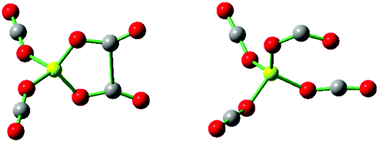Infrared spectroscopy of Be(CO2)4+ in the gas phase: electron transfer and C–C coupling of CO2†
Abstract
Beryllium–carbon dioxide cation complexes Be(CO2)n+ are produced by a laser vaporization-supersonic expansion ion source in the gas phase. Mass-selected infrared photodissociation spectroscopy supplemented by theoretical calculations confirms that Be(CO2)4+ is a coordination saturated complex that can be assigned to a mixture of two isomers. The first structure involves a bent CO2− ligand that is bound in a monodentate η1-O coordination mode. Another isomer has a metal oxalate-type C2O4− moiety with a C–C hemibond.



 Please wait while we load your content...
Please wait while we load your content...